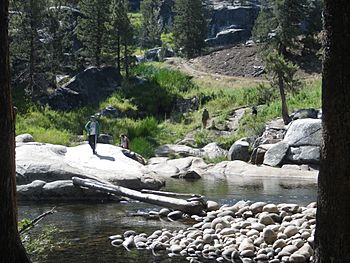South Fork San Joaquin River facts for kids
Quick facts for kids South Fork San Joaquin River |
|
|---|---|

South Fork at Mono Hot Springs
|
|
|
Location of South Fork San Joaquin River in California
|
|
| Country | United States |
| State | California |
| Physical characteristics | |
| Main source | Martha Lake (California) Kings Canyon National Park 11,010 ft (3,360 m) 37°05′39″N 118°43′16″W / 37.09417°N 118.72111°W |
| River mouth | San Joaquin River Ansel Adams Wilderness 3,704 ft (1,129 m) 37°26′13″N 119°14′36″W / 37.43694°N 119.24333°W |
| Length | 48 mi (77 km) |
The South Fork San Joaquin River is a major river in central California, United States. It's the biggest stream that feeds into the main San Joaquin River. This river is about 48 miles (77 km) long. It flows through the tall Sierra Nevada mountains. The river helps drain a large area about 60 miles (97 km) northeast of Fresno.
Contents
Where the River Flows
The South Fork San Joaquin River starts at Martha Lake (California). This lake is very high up, about 11,010 feet (3,356 meters) above sea level. It's located near Mount Goddard in Kings Canyon National Park in Fresno County.
Journey Through Canyons and Forests
The river flows northwest through a narrow place called Goddard Canyon. It gets more water from Evolution Creek, which joins it from the east. Then, it leaves the national park when Piute Creek flows into it from the north. At this point, the river enters the Sierra National Forest.
The South Fork then turns west and flows through Blayney Meadows. It reaches Florence Lake, which is held back by the Florence Lake Dam. After the dam, the river briefly goes north, getting water from Bear Creek. Then it turns west again.
It flows through a wider valley past Mono Hot Springs. Here, its main branch, Mono Creek, joins it from the north. The South Fork then enters the Ansel Adams Wilderness. It turns northwest and gets more water from Four Forks and Rube Creeks.
Joining the Main River
Soon after, the river crosses into Madera County. It then joins the larger San Joaquin River in a deep granite canyon. This meeting point is just a short distance above Mammoth Pool Reservoir.
How the River is Used
The South Fork San Joaquin River has been changed by dams. These dams help create electricity for people.
Dams and Power
The Florence Lake Dam is on the South Fork. Another dam, Vermillion Valley Dam, is on Mono Creek. This dam creates Lake Thomas A. Edison. Both dams are part of a big project called the Big Creek Hydroelectric Project. This project is run by Southern California Edison. It helps provide electricity to places like Los Angeles.
In 1925, water from the South Fork was first sent through a tunnel called the Ward Tunnel to Huntington Lake. The Florence Lake Dam was finished in 1926. It's made of concrete and helps make sure there's water all year for the tunnel. The Vermillion Valley Dam is bigger and was built later, in 1953.
These dams take a lot of water from the South Fork. This is especially true in late summer and fall. During these times, the river's natural water levels are already low.
Fun on the River
The South Fork San Joaquin River offers different kinds of fun for people who like to be on the water.
Boating Adventures
Between Piute Creek and Florence Lake, the river has different levels of difficulty for boating. Some parts, like Blayney Meadows, are calm and gentle. Other parts are very challenging, with fast-moving water and rapids. These are called Class VI to V+ whitewater. This difficult section is in the last 2 miles (3.2 km) before Florence Lake. There are also waterfalls that boaters must carry their boats around.
Below the Florence Lake Dam, the river's water levels can be less predictable. This is because water is taken out for power. However, in years with a lot of snowmelt, the river can still have strong flows for boating.


